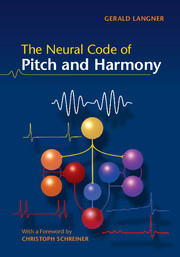Book contents
- Frontmatter
- Contents
- Preface
- Foreword
- 1 Historical aspects of harmony
- 2 Sound and periodicity
- 3 The discovery of the missing fundamental
- 4 The pitch puzzle
- 5 The auditory time constant
- 6 Pathways of hearing
- 7 Periodicity coding in the brainstem
- 8 Periodicity coding in the midbrain
- 9 Theories of periodicity coding
- 10 Periodotopy
- 11 The neural code of harmony
- 12 The oscillating brain
- References
- Index
5 - The auditory time constant
Published online by Cambridge University Press: 05 May 2015
- Frontmatter
- Contents
- Preface
- Foreword
- 1 Historical aspects of harmony
- 2 Sound and periodicity
- 3 The discovery of the missing fundamental
- 4 The pitch puzzle
- 5 The auditory time constant
- 6 Pathways of hearing
- 7 Periodicity coding in the brainstem
- 8 Periodicity coding in the midbrain
- 9 Theories of periodicity coding
- 10 Periodotopy
- 11 The neural code of harmony
- 12 The oscillating brain
- References
- Index
Summary
‘Panpipes and flutes obey the same law.’
From a Chinese fairy tale by Tung Chou Li Kuo Tse, about 1600
(Hornbostel, 1928)A quantum effect of pitch shift
In the previous chapter the pitch shifts measured by Schouten were analysed by employing periods instead of frequencies for the signal as well as for the perceived pitches. The resulting linear approximations of the pitch shifts in the time domain revealed auditory mechanisms which are obviously able to extract integer multiples of the period of the carrier.
Moreover, it also provided evidence for perceptual time constants that are not related to the periods of the signal. Actually, these constants may be put down to just one, since they are also integer multiples, not of a signal period but of an intrinsic auditory time constant of 0.40 ms. It will be shown in the following that this value is characteristic for the hearing system and seems to function as a kind of auditory benchmark, not only in human speech and music, but also in animal communication (see also Chapter 9).
The presumed auditory time constant becomes even more plausible by another perceptual effect that may be called the ‘third’ or ‘quantal effect of pitch shift’ (Langner, 1981, 1983). When experimental subjects compared the residual pitch of an AM signal (see Fig. 4.4) with that of a pure tone, they frequently reported that, although they heard the pitch increase with the carrier frequency f c, it did so not in a continuous, but in a staircase like manner. The pitch steps were small but of equal size when measured in the time domain – that is, as temporal intervals.
As an example, Fig. 5.1 shows results from such measurements (Langner, 1981). Two subjects compared the pitch of an AM signal with varying carrier frequency to that of pure tones.
- Type
- Chapter
- Information
- The Neural Code of Pitch and Harmony , pp. 46 - 59Publisher: Cambridge University PressPrint publication year: 2015



